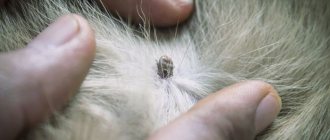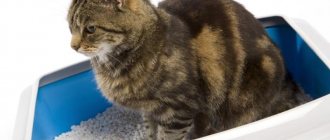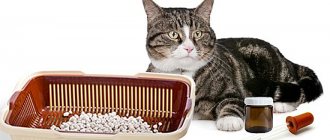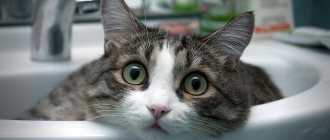A cat's diet before and after castration has significant differences. Changes in hormonal levels lead to obesity in castrates and the development of urolithiasis. Can a neutered cat be given fish? The animal's menu must be balanced in terms of protein, vitamins, microelements, and calories.
Cats and cats, if trained, get used to fish and can go on a “hunger strike”, demanding their favorite product. However, such nutrition is harmful for them, especially after castration, despite the prevailing stereotype of feeding pets.
Fish products for cats
Only a few species are able to fish. However, most members of the cat family like the taste of raw fish and eat it with pleasure. Why is this diet dangerous for a cat?
- The danger of infection with helminths, namely, cat fluke. This worm infects the liver and pancreas of a fish-eating cat due to insufficient heat treatment of fish of the carp family.
- Long-term raw fish consumption leads to anemia and hypovitaminosis. A lack of vitamins B and E begins to be felt.
- Blood clotting is impaired.
- Phosphorus and magnesium contained in fish provoke the deposition of salts in the kidneys and bladder. Struvite crystals of tripel phosphates are formed.
- Sea fish contains a lot of salt and iodine. Hyperthyroidism is a disease of the thyroid gland not only in humans, but also in cats, the cause of which is an excess of iodine. Salt is harmful to the kidneys.
- Fish bones injure the animal’s larynx, esophagus, and intestines, causing inflammation.
- Freshwater fish from polluted reservoirs or special nurseries contains substances harmful to the body of cats (heavy metals, pesticides, antibiotics).
The listed harmful qualities of raw fish do not mean that it should be completely excluded from the cat’s diet. It is acceptable to feed boiled fish without bones once a week: sea bass, cod, herring. In this case, infection with worms is eliminated, the destruction of vitamin B is neutralized, and the cat will receive a tasty addition to its menu. This does not apply to animals after castration. Castrated cats should not be fed fish .
Review of brands
Economy class food is not suitable: these are Friskas , NashaMarka , Kitikat , Whiskas . They contain 0.5% proteins, a lot of useless carbohydrates, and chemical flavor enhancers.
Manufacturers of premium and super premium products produce special lines for sterilized and neutered animals marked Sterilized . They are characterized by a reduced content of fat, phosphorus and magnesium.
Here are examples of special feeds in the mid-price category:
- Royal Canin. The diversity of the assortment is considered a plus. The manufacturer has developed 4 types of products: for kittens up to one year old, up to 7, over 7, and over 12 years old. In addition to dry granules, semi-liquid jellies, sauces, and pates are produced. Dehydrated poultry protein is listed at the top of the ingredient list, but its origin is not specified.
- Hill's. The company produces 3 varieties: dry granules for cats from 6 months to 6 years, over 6, and spiders. The first line of the list of ingredients is chicken, the composition includes L-carnitine, fat does not exceed 9%.
- 1st Choice. The products are made from fresh chicken. The food has a good composition of plant carbohydrates: it does not contain unhealthful corn and wheat, but contains brown rice, oat and barley kernels.
- ProPlan. In addition to dry food, the company produces canned and packaged food with poultry, ocean fish, and beef. The amount of protein reaches 41%, but wheat and corn gluten are present.
- Holistic products have a high protein content: from 40 to 75%, these are Now Natural, Acana, Go!, Orijen. There are no special dietary lines among them, but they are suitable for pets after sterilization. Holistic medications are given to animals with renal impairment with caution.
The pet is fed twice a day; granules should not be poured into the bowl uncontrollably. The daily dose is prescribed on the package, it is divided into 2 equal parts. Dry and wet food alternate, stick to products of the same brand.
Harm from fish for cats after castration
Castration is a blow to hormonal levels. The cat’s body feels an imbalance of metabolic processes, which there is nothing to regulate. Appetite remains the same, but metabolism slows down due to castration. For this reason, castrated cats should not overeat. Obesity due to castration develops quickly, which can be recognized by the fat fold on the ribs. The functioning of the liver and pancreas is disrupted. If the cat becomes infected with opisthorchiasis (feline fluke), the animal’s condition will sharply worsen.
Fat tissue retains water, impairing kidney function. Overeating contributes to changes in the acid-base composition of urine. Protein foods make urine more concentrated. The result is urolithiasis. It is not advisable for castrates to consume fish, whole milk products rich in protein and calcium.
Excess salt from eating fish causes water retention in the body , increasing the load on the kidneys. Urination becomes less frequent, and urosalites (oxalates, struvites) begin to crystallize in the bladder and kidneys. This accelerates the manifestation of urolithiasis due to castration.
Thyroid dysfunction with excess iodine also affects metabolic processes, causing an even greater imbalance in the animal’s endocrine system after castration. Excessive appetite is one of the signs of hyperthyroidism. Giving castrated cats fish and seafood, such as hake, cod liver, haddock, and raw river fish, is harmful.
What to feed a sterilized cat to keep him healthy?
For castrated animals, it is important to properly think through the diet, because...
In addition to obesity, sterilized cats are prone to urolithiasis. The urethra - the urinary canal - is very narrow in uncastrated individuals, while after sterilization it becomes even thinner. Therefore, anything that makes it difficult for cats to urinate causes pain. Sand and especially stones create an insurmountable problem for a sterile animal - it is all the more important to prevent their formation. To do this, carefully select the diet, trying to exclude foods that contain large quantities of calcium, phosphorus and magnesium, which contribute to the formation of urolithiasis crystals. Is it possible to feed a neutered cat fish? It is fish and seafood that contain a lot of phosphorus and calcium, so they should not be on the animal’s menu.
Proper food for sterilized animals can be either natural or ready-made - in the form of canned food and dry food. A natural diet should consist of meat foods (poultry, beef), offal (beef heart, lung, chicken stomach, beef and chicken liver). Pork is not given to castrated cats - it is fatty and quite difficult to digest and assimilate meat.
The presence of fermented milk products in the diet is considered mandatory: kefir, fermented baked milk, cottage cheese. Of course, all fermented milk products should also be low-fat. In addition, your furry pet’s menu should include porridge and vegetables. The latter are finely grated or crushed and added in this form to prepared food.
Ready-made freeze-dried or canned food must be strictly specialized. Each brand necessarily has food for sterile animals in its food line. What kind of food should I feed - dry or canned? Veterinarians note that cats urinate less often after castration.
Ready-made freeze-dried or canned food must be strictly specialized. Each brand necessarily has food for sterile animals in its food line. What kind of food should I feed - dry or canned? Veterinarians note that cats urinate less often after castration. This circumstance imposes certain obligations on animal owners.
Firstly, water must always be freely available. Secondly, you should carefully monitor how much your cat drinks. And if your pet comes to water rarely and reluctantly, it is recommended to soak part of the dry food in water and give it in the form of a paste, or even switch the cat to canned food or natural food.
For animals that consume enough water, you can alternate between dry food and canned food. Veterinarians recommend purchasing cat food from one manufacturer. This way you can avoid an excess or, on the contrary, a lack of important nutrients. And one more rule that should be followed: only one type of food can be used at one feeding - either dry or canned, but not mixed.
Proper food for sterilized animals can be either natural or ready-made - in the form of canned food and dry food. A natural diet should consist of meat foods (poultry, beef), offal (beef heart, lung, chicken stomach, beef and chicken liver). Pork is not given to castrated cats - it is fatty and quite difficult to digest and assimilate meat.
Symptoms of diseases caused by a fish diet
The root cause of all cat diseases after castration is improper nutrition with excess calories and protein. Determining whether a cat is overweight is simple:
- when stroking, you cannot feel the ribs and spine;
- there is no “waist” between the sternum and hips;
- hanging belly with folds.
Urolithiasis - the formation of sand, stones in the kidneys, bladder has the following symptoms:
- frequent or prolonged urination;
- pink urine;
- painful meowing;
- excessive cleanliness under the tail.
Natural nutrition
Sterilization is an operation to remove the ovaries. After the procedure, the production of sex hormones ceases, which entails physiological and behavioral changes in the cat with undesirable consequences:
- appetite increases;
- motor activity decreases;
- metabolism slows down;
- the number of urinations decreases.
The first three factors lead to weight gain and obesity, the last - stagnation of urine, the formation of sand and stones. The type of food does not change after sterilization, but it is better to review the “menu”. Read more: How to feed obese cats.
Cat's diet after castration
The question of what to feed a cat after castration is very important so that the pet remains healthy for many years. If he is accustomed to dry food, then now he needs high-quality food, premium or extra class, marked “for castrated cats.” The best option is wet canned chicken, lamb, beef in tetra packs or plastic bags.
Fresh water in the required amount is especially important when castrating and feeding dry food.
In castrated cats, high-calorie foods should be excluded from the diet:
- cheeses, full-fat cottage cheese, sour cream;
- pork;
- smoked meats;
- offal.
Lean meat, cereals, vegetables, vitamin supplements, skim milk, fermented milk products are the basis of nutrition after castration. If an animal loves fish very much, then it is possible to pamper it with its favorite food once every two weeks . But, subject to the following conditions:
- the cat is not overweight;
- low calorie content of the product;
- boiled look.
Cats live longer after castration, but for this you need to follow a diet, not forgetting about the physical activity of your pet.
When a fluffy kitten appears, a pressing question arises related to its diet - is it possible to feed a cat fish? There are opposing opinions of professional cat lovers and doctors on this matter. The current answer is still ambiguous. To understand all the pros and cons of feeding cats fish, you should recognize the types of fish, their dangerous properties, and benefits for the animal.
Avid cat lovers are sure that fish is healthy for cats. Indeed, certain types of fish are beneficial: they saturate the pet’s body with unique proteins, amino acids, omega-3, omega-6. Substances affect the functioning of the cardiovascular, skeletal, and reproductive systems.
Allowed fish species:
But for the most part, fish can provoke allergies in animals, have a bad effect on the kidneys and urinary system, and contribute to the development of urolithiasis.
Is it possible to feed a sterilized cat fish?
Doctors warn against feeding castrated and sterilized cats raw fish - this leads to urolithiasis and obesity.
Sterilization is a blow to the pet’s body. After the operation, it is necessary to feed the cat with special premium food. Boiled fish should be included in the diet, but not often.
It is forbidden to feed raw river fish to a cat. In addition to the danger of helminth infection and obesity, there is the possibility of disruption of the excretory systems, blood clotting, injury to the larynx and esophagus due to the process of eating meat with bones. May contain heavy metals, antibiotics, hazardous substances.
Sea fish contains a lot of salt and iodine. Feeding her meat can lead to hyperthyroidism - a disease of the thyroid gland, the cause of the disease is excess iodine in the body.
How often can you feed your cat fish?
Professional breeders give three arguments in favor of feeding cats fish regularly:
- Village cats eat fish all the time and live up to 20 years.
- Fish is a source of healthy vitamins.
- They sell packaged fish feed.
There is one important counter-argument to these arguments. Cats, of course, can be given fish (see the list of permitted fish), but it must be boiled, without bones, and no more than once a week. In industrial feeds, fish are pre-treated, most often fishmeal is added to the bags - a flavoring substance reminiscent of fish. The vitamins that predominate in fish are easier to replace with special ones; they will be safe for your pet. Remember, veterinarians do not recommend combining fish and food from a pet store.
What to choose: ready-made food or natural food
Felinologists and veterinarians do not have a consensus on which food is better: natural or industrially produced. The owners must decide for themselves on this issue. Most people today prefer the latter option as it is much more convenient. There is no need to cook for your pet, and the costs are about the same.
The only thing that all experts agree on is that human food is not suitable for cats, whether neutered or not.
Ready-made food is good because it contains all the necessary nutrients, vitamins and elements. By choosing the right food from a good manufacturer, you can be sure that your pet’s body receives a balanced set of compounds that is suitable specifically for its individual characteristics. With this feeding, there is no great need to give the cat vitamin supplements. True, vitamin courses are periodically recommended for large and long-haired animals.
Many experts are supporters of a natural diet. This is explained by the fact that the animal better assimilates food that it can obtain in natural conditions. A cat cannot catch a mouse or a bird in an apartment, and its owners certainly will not do this on the street. But meat is meat, and this product should form the basis of a cat's diet. You should choose low-fat varieties. It is better not to give it raw; boiled meat is best. Meat by-products are also beneficial for a cat’s body.
The predator's digestive tract hardly digests cereals and plant fibers. You can diversify your diet with porridges made with meat broth, but you should not give such food too often.
Starchy vegetables with a high glycemic index are also not suitable for feeding a neutered cat.
The diet should contain dairy products (low-fat cottage cheese, kefir, yogurt, low-salt cheeses). You can sometimes give your animal chicken or quail eggs.
Specialized stores sell special pots of lawn grass. Many cats love to nibble on this kind of grass, getting the necessary substances from it.
With a natural diet, it is necessary to take a course of vitamin and mineral supplements at least twice a year in order to maintain the animal’s immune status at the proper level.
Be sure to read the article about vitamin deficiency in cats; this problem is especially relevant for neutered animals.
Why cats can't fish
Opponents of feeding rely on the following considerations:
- The product contains a lot of bones that can injure the cat.
- The product contains too much protein and minerals. If you use the product for a long time, this factor can actually have an adverse effect. But who is stopping you from feeding in moderation as part of a balanced diet?
- Fish muscles are infected with helminth larvae. A reliable method of inactivation is freezing in a household refrigerator at -18°C for a week, or boiling for 15-20 minutes after boiling.
- The insides of river inhabitants contain the enzyme Thiaminase, which removes vitamin B1 (Thiamin) from the body. Cooking for 40 minutes inactivates the anti-nutrient enzyme.
- Certain types of marine life, primarily pollock, contain the anti-nutrient substance Trimethyloxide, which converts the iron contained in food into an indigestible form. The harmful substance decomposes after fifteen minutes of boiling.
All types of heat treatment available at home denature proteins and impair their absorption. Some of the proteins are lost as they go into the broth. However, the cooked product remains highly nutritious.
Why do neutered cats need a diet?
Sterilization is depriving an animal of the ability to give birth. If you decide to sterilize a cat, this almost certainly means that during the operation her internal reproductive organs will be removed - the ovaries and uterus, that is, strictly speaking, she will be castrated.
What then? Since these organs (mainly the ovaries) produced female sex hormones, which are responsible for many processes in the body, their removal will lead to various consequences.
Estrogens tend to suppress appetite. In addition, sex hormones speed up metabolism. If they stop being produced, the animal’s appetite increases, and at the same time metabolism slows down. As a result, we get a tendency towards obesity.
If we talk about how to properly feed neutered cats, then we need to proceed from this conclusion. If previously the animal had a full bowl, from which the cat ate a little at a time and did not gain excess weight, now she will eat everything and ask for more, gradually turning into a bun.
Developers of pet food have long been concerned with this problem and have created lines of food for sterilized animals: as a rule, they have lower calorie content due to their reduced fat content.
Can a neutered cat be given fish?
If fish poses a threat to ordinary cats, it is even more so for castrated animals. The product is rich in proteins. During the biological processing of proteins, uric acid is formed - a nitrogenous slag that is poorly soluble in water and urine. Salts precipitate and stones form, blocking the urine pathways.
Urolithiasis (urolithiasis, urolithiasis) develops. If you give a cooked product, the amount of uric acid increases, which means more nitrogenous waste is formed. This is the main objection to feeding fish to sterilized cats.
However, the product can be fed to sterilized animals as part of ready-made professional feed. Gentle processing methods used by manufacturers make it possible to inactivate helminth larvae and destroy Thiaminase and Trimethyloxide. At the same time, the proteins retain all their beneficial properties.
Still, you cannot feed neutered pets fresh fish in large quantities. The cat receives a complete dry food mixture, balanced in all nutrients, and the addition of the product will increase the concentration of nitrogenous substances. The body will need to utilize excess protein, but in this case salts are formed, which precipitate and turn into stones.
The second point: in ready-made food, natural buffer components are used that keep the pH of urine within limits that prevent the crystallization of salts. Fish supplements lead to electrolyte imbalance.
So, should we take away the joy of sterilized pets? Of course not. Feeding fish should not exceed 10% of the diet weight, no more than 2 times a week.
Mr. Cat recommends: feeding regimen
After surgery, it is not recommended to change either your diet or feeding regimen. The animal has already suffered stress; there is no need to create additional difficulties for it. Experts recommend feeding the animal two or three times a day.
If the cat eats ready-made food, then you can leave the daily portion in a bowl, and the animal will eat when it wants. However, this option may not be suitable for those whose cat is prone to overeating. Having finished the daily requirement in one or two sittings, by the evening he will begin to pester his owner with requests to feed him. In such cases, it is better to divide this amount by the usual number of feedings and give strictly dosed amounts of food in a timely manner.
With a natural diet, it is recommended to remove food immediately after the meal so that it does not spoil. Every meal you need to give your cat freshly prepared food.
What harm can fish do to a cat?
Uncontrolled feeding of fresh food to cats can be harmful to health:
- Large bones are dangerous. They dig into the soft tissues of the mouth, throat and esophagus and can cause pain, vomiting and inflammation.
- Gluttony causes stomach fullness and vomiting.
- Thiaminase fish, mainly freshwater fish from the carp family, destroys vitamin B1, impairs appetite and has a negative effect on the skin and coat.
- Trimethyloxide varieties cause anemia and a decrease in the intensity of coat color.
- An increased concentration of proteins increases the load on the liver and kidneys and causes their disease. Therefore, you should not pamper your pets with fish every day.
How to properly include the product in your diet
It is acceptable to give fish infrequently and in small portions. It is better to take pink salmon and more noble sea fish. But the salmon on store shelves are most often farmed. During feeding, they are given antibiotics, antifungal drugs and various food additives that are potential carcinogens.
The most preferable are moose and cod. If pets are overweight or prone to it, then you should choose lean varieties (for example, haddock, flounder). Fatty sea fish can be included in a cat's diet, which is suitable for feeding kittens and individuals leading an active lifestyle.
Cats who are preparing to become mothers are contraindicated in eating fish, even boiled, as this negatively affects the development of the fetus. Even if a cat eats dry fish-based food, kidney problems may occur.
If your pet eats professional food, then it is allowed to add fishmeal to wet and canned food as a source of natural protein. Based on its health status and needs, your cat can be given fish oil-based vitamins, which can be purchased at a veterinary pharmacy.
Thus, occasionally you can pamper your favorite purr with a treat, provided that the fish is properly selected and prepared. In this case, the pet’s body will not be harmed, and food addictions will not cause its early death.
In the debate whether it is possible to give fish to cats, the grain of truth has not yet been found. The categorical “no” coming from biologists comes into irreconcilable contradiction with the experience of cat lovers, whose wild ducks lived to gray hairs by eating only fish.
What are the benefits of fish for cats?
Fish is a valuable protein product that is superior to meat in amino acid composition. Fats are rich in essential Omega 3 acids, which are low in vegetable oils. When feeding fish, pets feel better, their skin becomes elastic, and their coat becomes beautiful.
The fresh product is included in the composition of ready-made super-premium food, and fishmeal is present in the premium food recipe. It is best to give cats small fish with tender bones rich in calcium, magnesium, iodine, while fillets contain excess phosphorus. Large bones are first removed.
About the benefits of milk for a cat
Pets happily lapping up milk is a standard image that many take for granted. But is the product really good for cats? Babies suckling from their mother are naturally fed milk. And in composition it differs from what a cow gives.
Cow milk contains denatured protein and casein, which not only cats, but also some people have difficulty accepting. The composition does not contain the special enzyme lactose, which is necessary for the cat’s body to absorb milk sugar.
Therefore, there is no particular benefit from cow product for pets. But if the cat loves milk, and it does not provoke flatulence, then you can periodically pamper your pet.
Can cats eat raw fish?
Despite the possible presence of helminth larvae and anti-nutrients, the product is best fed raw. To prevent the accumulation of antinutrients, thiaminase production is alternated with trimethyloxide.
For example, they feed carp, and the next day pollock. However, for the constant use of fish, it is necessary to know its composition and have the skills to balance diets. Otherwise, you should not feed fish in quantities exceeding 10% of the weight of the feed mixture.
What about dry fish food?
Let's consider the composition of high-quality feeds, in which fish is used as the main source of protein (in cheap feeds, fishmeal acts only as a flavoring agent).
- Acana Pacifica: used whole herring, sardine and flounder (whole carcass with bones and giblets), whole sea bass and hake, cod fillet. The fat content of the feed is 20%, the calcium to phosphorus ratio is 1.4:1, choline chloride (vitamin B4) and vitamins K and E are added additionally.
- Now Natural Fish Adult Recipe: component No. 1 of trout fillet, additionally enriched with many vitamins, minerals and individual amino acids. 19% fat, phosphorus content is significantly less than in Akan.
- Aatu Cat Salmon{amp}amp;Herring: salmon fillet and whole herring. Vitamins A, D, E, iron, zinc, manganese and amino acids – additionally. 18% fat, calcium to phosphorus 1.3:1.
These foods are safe for cats because:
- no injuries from fish bones;
- the fish has been heat-treated - there are no parasites or substances that destroy vitamins;
- the balance of calcium and phosphorus is maintained;
- a large amount of animal protein maintains the acidic environment of urine, which is the best prevention of urolithiasis;
- vitamins and microelements are added additionally or at the expense of other feed components.
https://www.youtube.com/watch?v=ytadvertise
The only threat that remains open is the toxins contained in marine fish. The mercury content in animal feed should be controlled, but it is difficult to say whether this is actually the case. Owners should avoid constant use of dry and wet tuna-based food, as it is the leader in the content of heavy metals.
How much fish can you give your cat?
The maximum allowable amount is considered to be 40% of the total amount of protein in meat and fish feed. However, in professionally prepared super-premium products, it is possible to use mono-protein feed mixtures, the animal proteins of which are entirely represented by fish.
If the protein content in meat and fish feed is unknown, you can feed no more than two parts of fish per 3 parts by weight of meat; it cannot be used as the basis of the diet. If possible, the cat is given fish days 1 or 2 times a week.
Sterilization is not to blame
Sterilization is the right way to prolong a pet’s life and improve its quality. But health largely depends on proper feeding. No matter how “cute” a plump cat may look, we should not forget that this is an obese animal that is at risk of developing diabetes, problems with joints, heart, kidneys, liver, and is unable to lead an active lifestyle and play.
It is not the food or the operation itself that is to blame for obesity - the responsibility lies primarily with the owners, so it is better not to neglect the advice of veterinarians on how to properly feed a sterilized cat.
Feed your cat correctly after castration, and you will not notice any changes in her character and complexion. She will be as active, playful and healthy as before.











